
About Spiders
Spiders belong to the class Arachnida. They have eight legs, lack antennae, and have web-spinning spinnerets. Though most spiders found in homes are harmless to people, their presence often causes fear and anxiety.
- Spiders are often mistaken for insects, but they are actually arachnids. Unlike insects, which have six legs and three body parts, spiders have eight legs and two body parts – a cephalothorax (fused head and thorax) and an abdomen.
- While some spider bites can be painful or cause localized swelling, very few spider species in North America pose a serious threat to human health.
Spiders in Your Home
Spiders often enter homes through cracks, around windows and doors, or in boxes and other items. They prefer to live in dark, cluttered, and undisturbed areas, such as basements, attics, corners, and behind furniture. While some spiders may build elaborate webs in attics or crawlspaces, others prefer less conspicuous locations.
Despite their reputation, most spiders pose minimal risk to humans. The vast majority of spider species found in homes lack the venom potency or aggressive behavior to harm people. In New York, yellow sac spiders are the only poisonous species that poses a risk to humans. Brown recluse and black widows are sometimes reported, but these cases are extremely rare (neither species is native to New York).
If you encounter a spider in your home, the best course of action is usually to leave it alone. However, if the spider is large or in a high-traffic area, there are humane ways to remove it. The most common method is to trap the spider under a cup and gently release it outdoors. For those seeking a more proactive approach, regularly cleaning and decluttering your home can eliminate spider hiding spots and discourage them from staying.
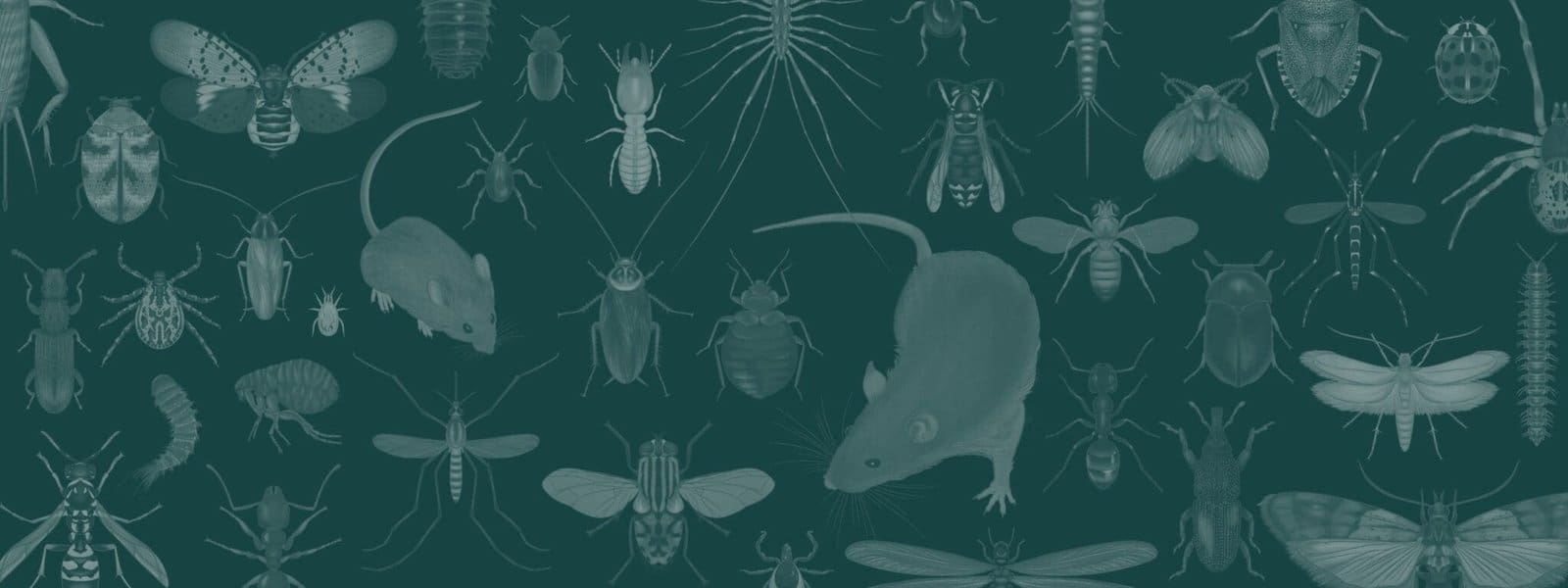
Pest Species in New York City / Tri-State Area:
Common House Spider
Parasteatoda tepidariorum
Common house spiders live in close proximity to humans and are found almost exclusively in homes and buildings.
They construct densely-woven, 3-dimenional webs that appear random or tangled. Webs are usually constructed in dry, secluded areas like in the corners of walls and windows.
These spiders only bite in self-defense. Their bites are slightly painful (akin to a bee sting) but not dangerous.
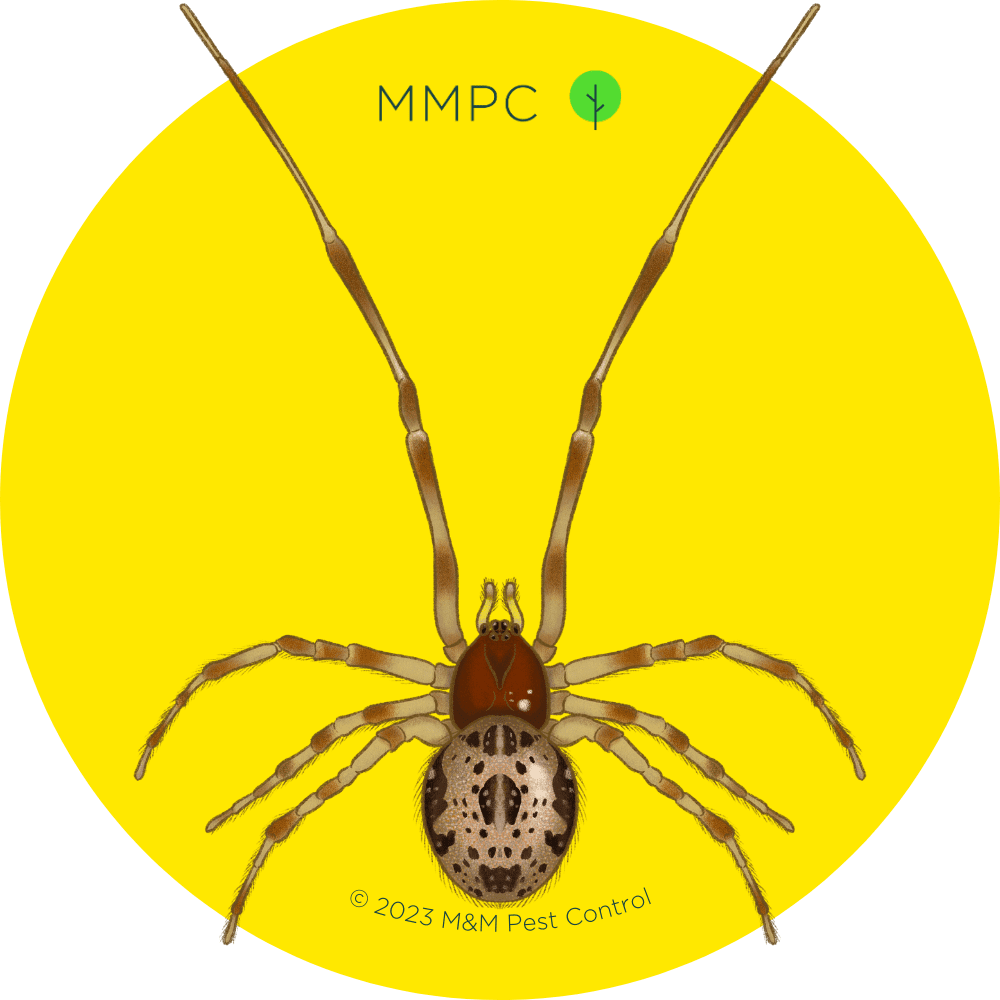
Size: 1/6″ – 1/4″ long (4 – 6 mm) not including legs; about the size of a flax seed
Color: Brown and tan
Shape: 2 body segments with a rounded abdomen and 8 long legs
Identifying Features
- 8 long, tan legs with dark stripes (1st pair is extra long)
- 8 eyes arranged in 2 rows
- 2 body segments (cephalothorax and abdomen) mottled with light and dark markings
- Abdomen is large and bulbous in females, small and rounded in males
Yellow Garden Spider
Argiope aurantia
Yellow garden spiders are typically found in yards and gardens. They rarely come indoors but may build their webs on the outside of windows and other structures.
As a part of orb weaver family, their webs are large, circular, and complex. Yellow garden spiders in particular can be identified by the bold, zig-zagging lines they weave across their webs.
These spiders are not poisonous and rarely bite (only when threatened).
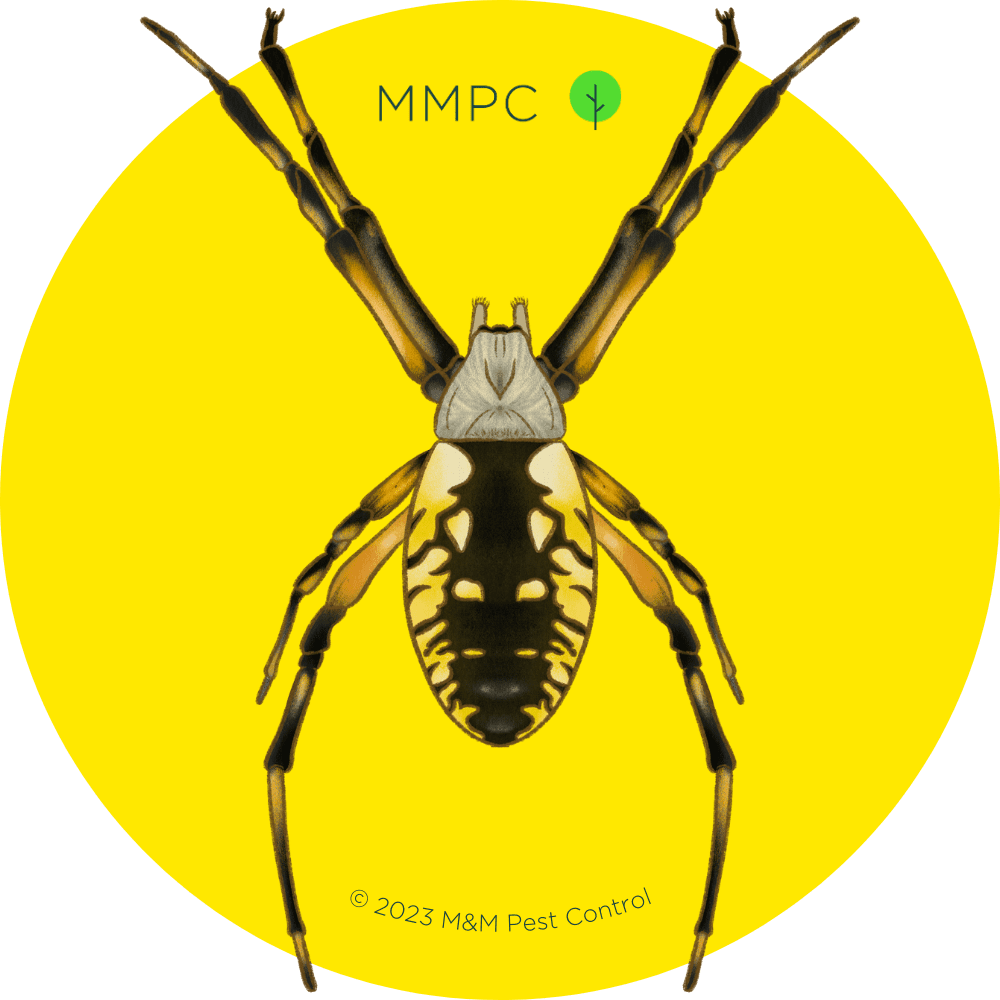
Size: Females are 3/4″ – 1″ long (19 – 28 mm); males are 1/5″ – 3/8″ long (5 – 9 mm)
Color: Yellow and black
Shape: 2 body segments with a hairy cephalothorax, a smooth abdomen, and 8 long legs
Identifying Features
- 8 long, black legs with pale yellow or orange patches (3rd pair is shortened)
- 8 eyes arranged in 2 rows
- 2 body segments (cephalothorax and abdomen)
- Cephalothorax covered in short, silvery-white hairs
- Smooth, shiny abdomen with symmetrical yellow and black markings
Grass Spiders
Agelenopsis spp.
Grass spiders live in grassy areas, but they occasionally wander indoors in search of food and warmth during the winter.
These spiders build unique, funnel-shaped webs designed to trap flying insects. Their webs consist of a flat, sheet-like section (up to 3 feet wide) with a downward-leading funnel (up to a foot or longer).
Grass spiders are shy and only bite when threatened. Their bites may be painful but are usually harmless (except in rare cases).
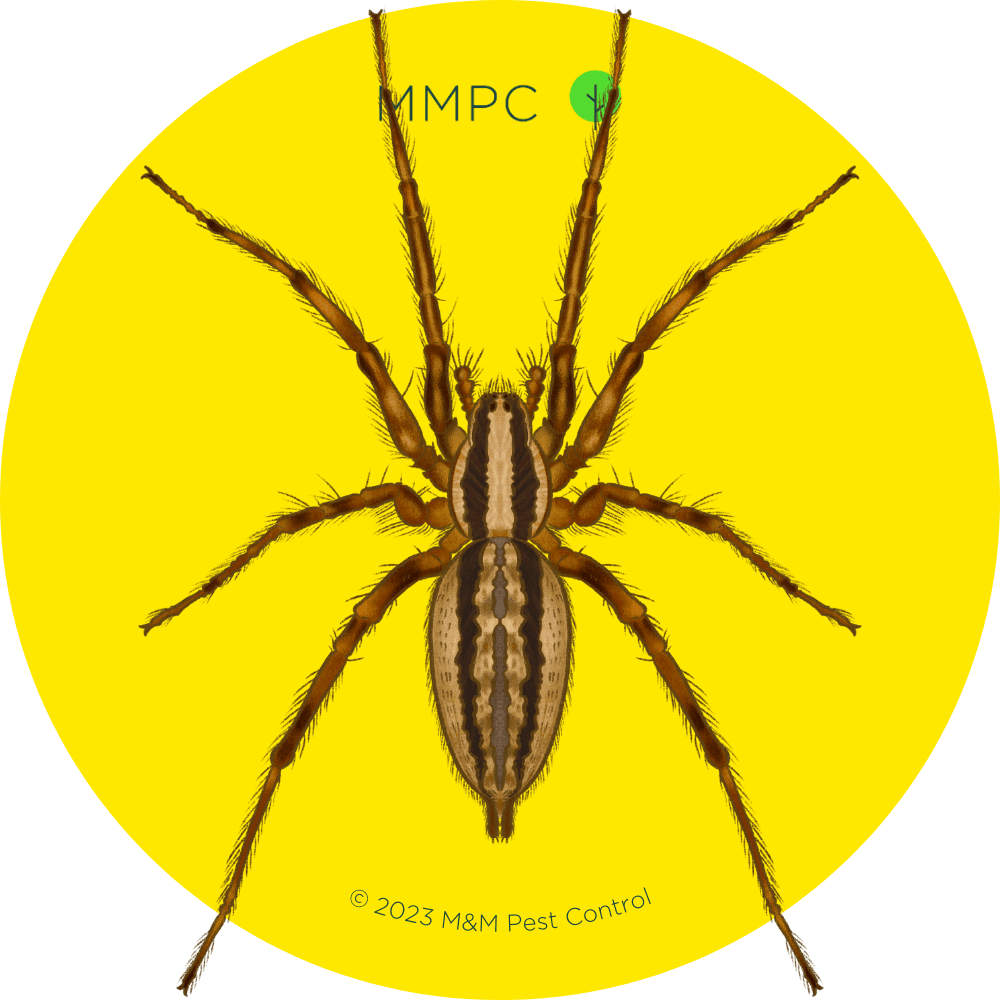
Size: 3/8″ – 3/4″ long (9 – 20 mm) not including legs; about the size of a sunflower seed
Color: Brown and yellowish-brown
Shape: 2 body segments with an oval-shaped abdomen, tail-like spinnerets, and 8 long, bristly legs
Identifying Features
- 8 long, bristly legs with light and dark patches
- 8 eyes arranged in 3 rows
- 2 body segments (cephalothorax and abdomen) covered in short, bristly brown hair
- 2 parallel dark stripes along the back of its carapace
- Long, tail-like spinnerets protruding from the rear
Wolf Spiders
Lycosidae spp.
Wolf spiders get their name from the way they chase down and pounce on their prey (like wolves). They’re usually found outside but may occasionally wander indoors.
Wolf spiders do not spin webs.
They’re also known for lugging their eggs around in big, round, silken sacs attached behind the abdomen of female wolf spiders.
They only bite when threatened. Their bites may be painful but are usually harmless.

Size: 3/8″ – 1 3/8″ long (10 – 35 mm) not including legs; about the size of a paperclip
Color: Dark brown to gray
Shape: 2 body segments with an oval-shaped abdomen and 8 long, bristly legs
Identifying Features
- 8 long, bristly legs with light and dark patches
- 8 eyes arranged in 3 rows
- 2 body segments (cephalothorax and abdomen) covered in short, bristly brown hair
- Thick, dark bands along the back of its carapace
- During the spring and summer, may be seen carrying around a large, white egg sac attached to the abdomen
Yellow Sac Spiders
Cheiracanthium spp.
Yellow sac spiders account for the majority of reported spider bites. They are the only native spider species in New York that pose a risk to humans.
Their bites are moderately poisonous, causing pain, swelling, itchiness, and (typically mild) ulcerating sores.
These spiders normally live outside, but may wander indoors during the fall and winter in search of food and warmth. They weave small, silken tubes or sacs to rest in during the day and protect their young.

Size: 1/6″ – 3/8″ long (4 – 10 mm) not including legs; about the size of a pumpkin seed
Color: Pale yellow or straw-colored
Shape: 2 body segments with an oval-shaped abdomen and 8 long, thin legs
Identifying Features
- 8 long, thin legs that are pale yellow with dark brown tips (1st pair is extra long)
- 8 eyes arranged in 2 rows
- Dark brown fangs (chelicerae)
- 2 body segments (cephalothorax and abdomen) both pale yellow or straw-colored
- Faint dorsal stripe running down the center of the abdomen
Brown Recluse
Loxosceles reclusa
Brown recluse spiders are mainly found in the South and Central Midwest. They are not native to New York.
These spiders live alone and hide in dark, undisturbed places. They sometimes enter homes in search of prey, taking up residence in crevices, closets, storage boxes, and seldom-worn shoes or clothing.
They’re not aggressive and only bite when threatened. Their bites cause pain and sometimes serious skin damage, but are rarely life-threatening.
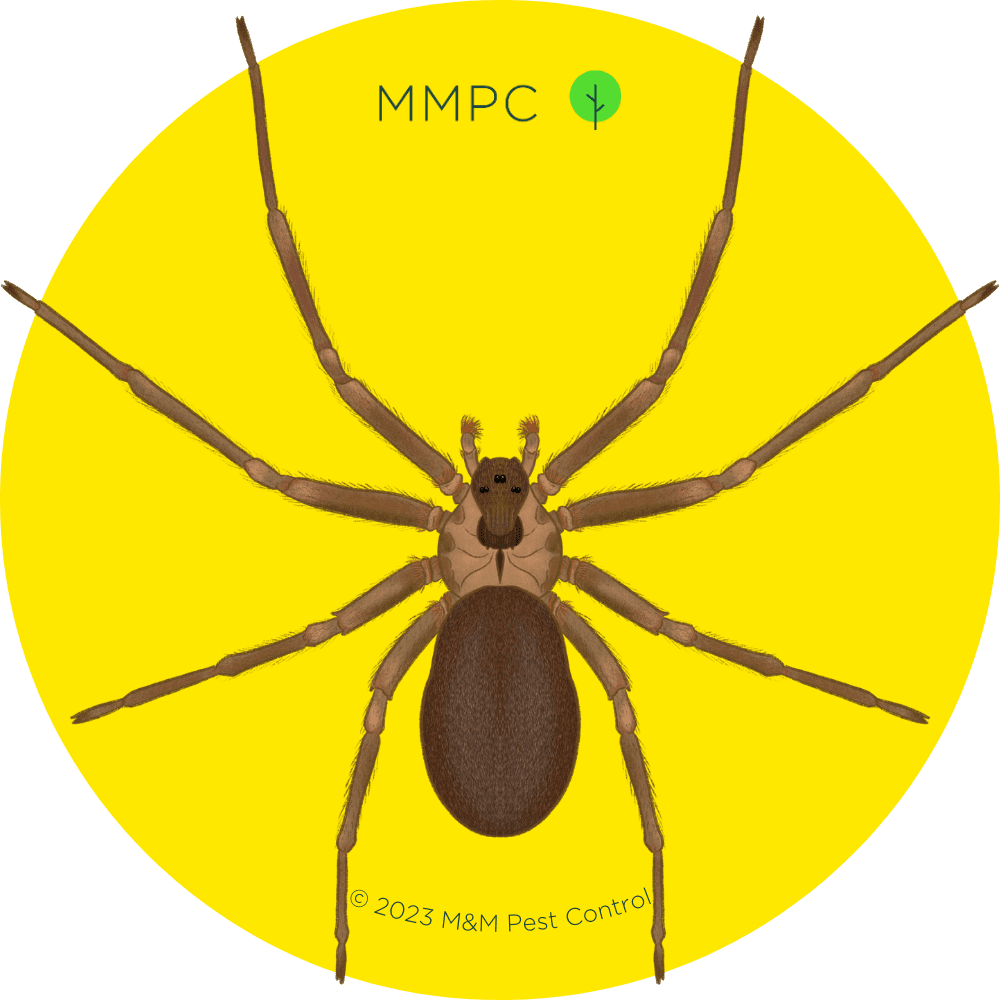
Size: 1/4″ – 1/2″ long (6 – 12 mm) not including legs; about the size of a black bean
Color: Tan to dark brown
Shape: 2 body segments with an oval-shaped abdomen and 8 long legs
Identifying Features
- 8 long, brown legs
- 6 eyes arranged in a distinct semicircle
- 2 body segments (cephalothorax and abdomen) covered in short brown hairs
- Dark, violin-shaped marking on the top of the cephalothorax (may be faint, especially in younger spiders)


